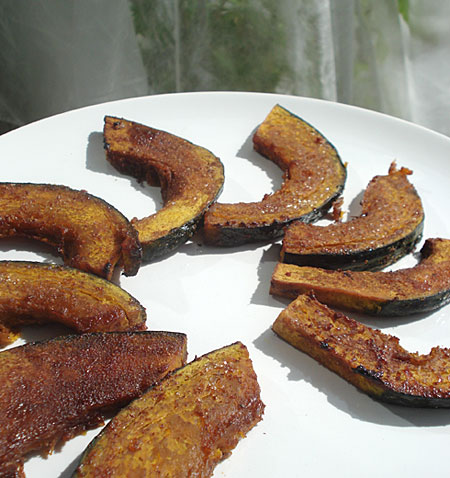
I hesitated to put this recipe up, because it's not the prettiest thing in the world. But it's so tasty, dead easy to make, and of this season - so, here it is. As a bonus it's full of fibre and is relatively low-calorie, low-sugar etc for people who want a bit of something sweet without going on a massive guilt trip.
Most recipes out there for using winter squash seem to involve pureeing them, but I rather like them when they are in chunks or slices. This roasted squash has a sweet, spicy and salty glaze of sorts on them, which brings out the dense sweetness of the fruit. Cut into fairly thin slices like this, it makes interesting finger food. You can vary the sugar and spice to your taste, though too much of either may overwhelm it.
You do need to use kabocha-type squash for this ideally, though butternut should work too. You will need a dense, starchy and sweet squash. Don't use regular pumpkin, which is too watery and lacks sweetness. (Rouge d'etampes pumpkin may work, but I've found their sweetness to vary quite a bit.)
Filed under:
japanese fall vegetarian sweet vegan
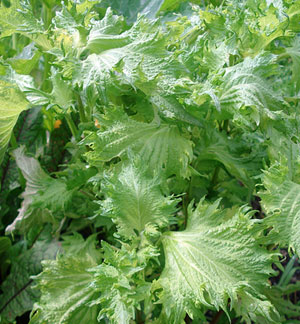
Around here it's already cool enough to declare that summer is over and fall is here. (Actually we had a very cold, wet summer anyway, but nevertheless.) So the summer vegetable plants in my garden are dying off, and I'm in the process of salvaging the remaining tomatoes and eggplants, picking the last zucchini, and eyeing the winter squash to see when they will be ready.
Tender herbs like basil are on their last legs, so I'm picking and preserving those flavors of summer so that they can brighten the dark winter months. Last year I took the lazy option and froze everything, packing the picked leaves in plastic bags and throwing them in our big locker-type freezer. Freezing is okay if you're too busy to do anything else with your herbs, but not really the optimal way all the time to keep tender herbs in the long run. So this year I'm thinking things through a bit more and considering how I want to use each herb, and preserving them accordingly. Each method is quite easy and really doesn't take that much time.
Filed under:
japanese preserves and pickles vegetarian herbs
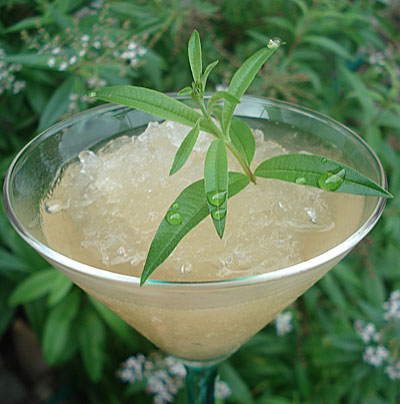
The lemon verbena plant that I planted last year and almost lost to a summer storm, is now firmly established and positively thriving. Whenever I pass it I can't resist rubbing a leaf, because it smells so wonderful.
Transferring that wonderful lemony scent to taste is quite easy - simply steeping it in some boiling water for about 10 to 15 minutes does the trick. This granita is infused with the aroma of lemon verbena, soured with a little lemon juice, and sweetened with a delicate acacia honey. Any light colored honey will work here instead. It makes a wonderful light dessert or palate cleanser, or cooling summer snack.
Filed under:
dessert lighter vegetarian sweet summer tea
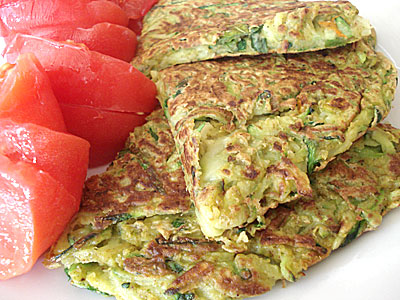
Continuing with my light and quick summer dishes:
This year we got a bit more serious than usual about our garden, and planted three zucchini plants. If you have a garden with zucchinis, you know that sometime around midsummer they start to produce babies like crazy. We've had a rather cold and rainy summer here up until now, but this week our three innocent looking zucchini plants have gone into high gear, and we're picking them as fast as we can before they turn into seedy, tasteless baseball bat sized monsters.
Zucchini pancakes are one way to use up a lot at once. This version uses chickpea flour instead of wheat flour or eggs, with a little bit of spice in it. It's great hot or cold, and is a perfect snack, side dish or complete vegan main dish, since the chickpea flour is such a terrific source of protein and carbs (nutritional info). Serve it with a salsa, curry, or just on its own. Here I just served them with some super-ripe tomato wedges. The shredded zucchini adds moisture and a rather creamy texture, which I love.
Chickpea flour is used in Mediterranean and Indian cooking. I get mine from a local Indian grocery store, where it's sold as gram flour; it's also known as besan, ceci flour, and so on.
Filed under:
lighter vegetables vegetarian summer vegan gluten-free
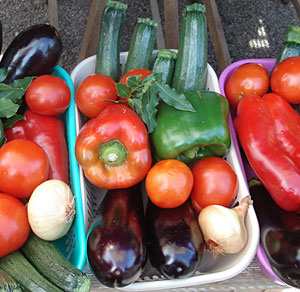
For the last two weeks I was in the Provence, I tried a short term experiment of cooking vegetarian dishes only. Here are some thoughts on that experiment.
As I've stated here before, I'm not a vegetarian though proportionately I don't eat much meat. Therefore, I thought that the experiment should go quite easily. It was easy in some respects, due to the easy availability of an abundance of fresh produce.
Filed under:
food travel vegetarian provence france
The comments on the post about whether vegetarian restaurants should only be reviewed by vegetarians have been really interesting - if you haven't read them yet, please take a look here. This has made me decide to do a small experiment. I'm here in Provence for three weeks, and I'll be cooking most of our meals (that's why we like to rent a place with a kitchen whenever we come here, as I wrote about last year). So, I'm going to make all of our meals in-house vegetarian. Lacto-vegetarian to be precise, since not having any of the delicious cheeses here would be too much of a sacrifice and the self-proclaimed 'bovo-vegetarian' in house will rebel before we've even started. We will be giving up eggs though (a hardship in itself since I love eggs), and meat and fish. (We might have a bouillabaise once at a restaurant.) I'll also try to stick as much as possible to locally produced food, though I'm not going to be as strict there. (E.g. I will use spices and things like lemons from elsewhere.)
Admittedly, here with all of the glorious locally produced fresh produce it should be a breeze. I doubt it will change my palette much but it will help me concentrate on coming up with different and tasty vegetarian dishes. The better results will be posted here of course!
Filed under:
essays food travel vegetarian provence
The Guardian, one of Britain's finest newspapers, recently installed several blogs to which their staff writers contribute, including a food blog. Last week one of their restaurant reviewers, Jay Rayner, wrote a negative review of a well known London vegetarian restaurant - which upset quite a lot of vegetarian readers. He defended his review, and several commenters bit back. One opinion expressed was that, since the critic is not a vegetarian himself, that he did not have the palate to judge vegetarian food, and that only committed vegetarian or vegans should be reviewing vegetarian restaurants.
That's an interesting point of view. While I doubt that main stream media outlets instituting such food-specific critics and such, in the wide world of blogs it is theoretically possible - so someone might choose to only trust restaurant reviews from a vegetarian blogger. Is it plausible though? Is an omnivore disqualified from judging what's good vegetarian food because his or her tastebuds are tainted by a fondness for meat? Should vegetarian food only appeal to non-meat eaters?
As someone who has gradually increased the percentage of vegetable based food in my diet in the last few years, but is not a vegetarian, I'm really curious about this. I do like the taste of meat. but I love the taste of fresh vegetables too. If I gave up meat products totally though, would my palate change that much, so that I enter a magical realm which is reserved only for vegetarians? Will meat become totally inedible? I'm a bit skeptical about this, since so many vegetarians seem to at least occasionally crave a 'meaty' taste.
Filed under:
essays vegetarian philosophy
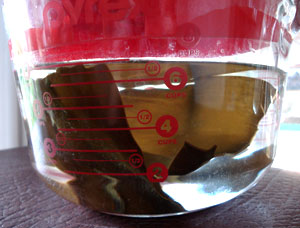
As I've stated many times here over the years, the basis of most Japanese savory foods is a good dashi, or stock. Dashi is not just used for soups, it's used for stewing, in sauces, batters, and many, many other things.
The regular way to make dashi was one of my first entries on Just Hungry. It uses kombu seaweed and dried bonito flakes (katsuobushi). Some people use niboshi, small dried fish, in addition to or instead of bonito flakes.
Katsuobushi and niboshi are both fish-based, so not vegetarian. So how do you make a good vegetarian, even vegan, dashi?
Filed under:
basics japanese soup vegetarian vegan
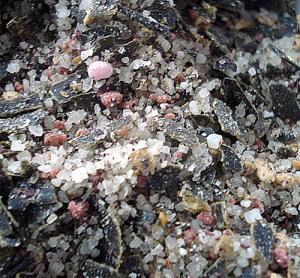
If you browse the aisles of a Japanese grocery, you may run across various instant tsukemono mixes. These come either in liquid or dry form. The dry granules in particular are very handy to have around, and they can make sokuseki zuke in a hurry. However, they usually contain MSG, preservatives and such.
Scouring around the Japanese parts of the interweb, I came across several pages that had recipes for a homemade instant tsukemono mixes, such as this one. They all used MSG or dashi stock granules though, and I wanted to come up with a mixture that was made up 100% of natural ingredients.
After some tinkering around and almost ruining the motor of my food processor, here's the mixture I came up with. To up the umami quotient it has a full 100 grams of finely chopped konbu seaweed in it. It also has some interesting very Japanese ingredients in it such as dried yuzu peel and yukari, dried powdered red shiso leaves.
Filed under:
japanese ingredients vegetarian vegan tsukemono
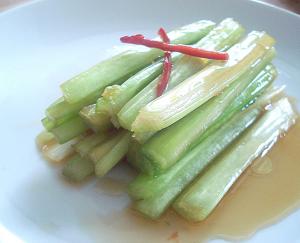
Celery isn't a very Japanese vegetable, but with the addition of the right flavors it can be turned into a refreshingly crunchy pickle that goes well with white rice, which is the base criteria for determining whether a pickle fits a Japanese meal or not. Besides, I always seem to have some celery in my fridge (who doesn't?), and this is a good excuse to use some up.
This is a nice salad-like pickle, that's best eaten with some of the pickling liquid spooned like dressing over the top. There's a nice bite and a color zing from the thin slivers of red chili pepper. (Pirikara means spicy-hot.) There's a little sake and mirin in the dressing, which gives it a twist.
Since celery is more fibrous than cucumber, it needs to marinade for a bit longer. Give it at least 3 hours, or overnight. It doesn't keep too well at room temperature, so reserve this for eating at home. It assembles as quickly as the other quick pickles in this series.
Filed under:
japanese lighter vegetables vegetarian vegan salad tsukemono
Pages